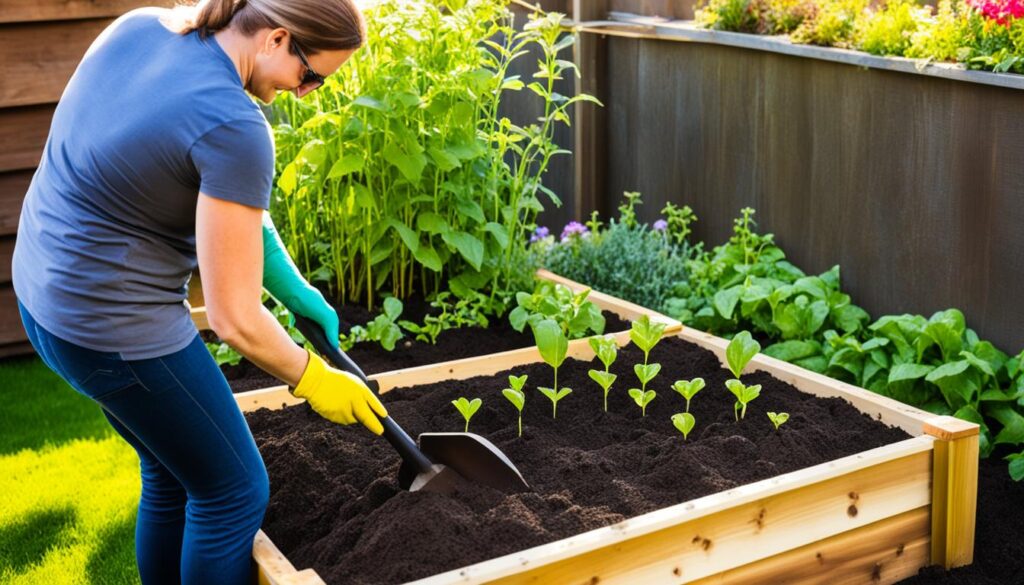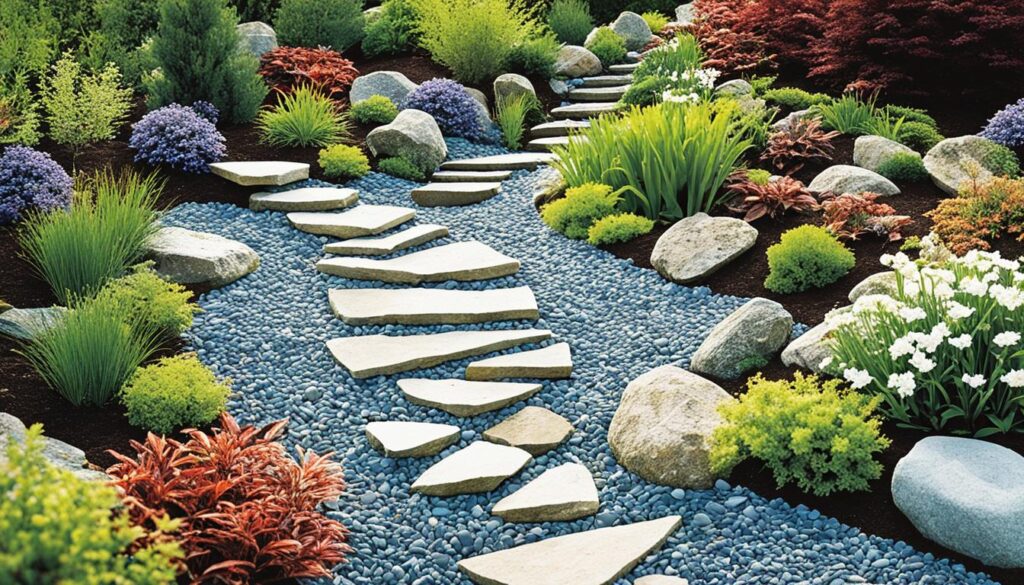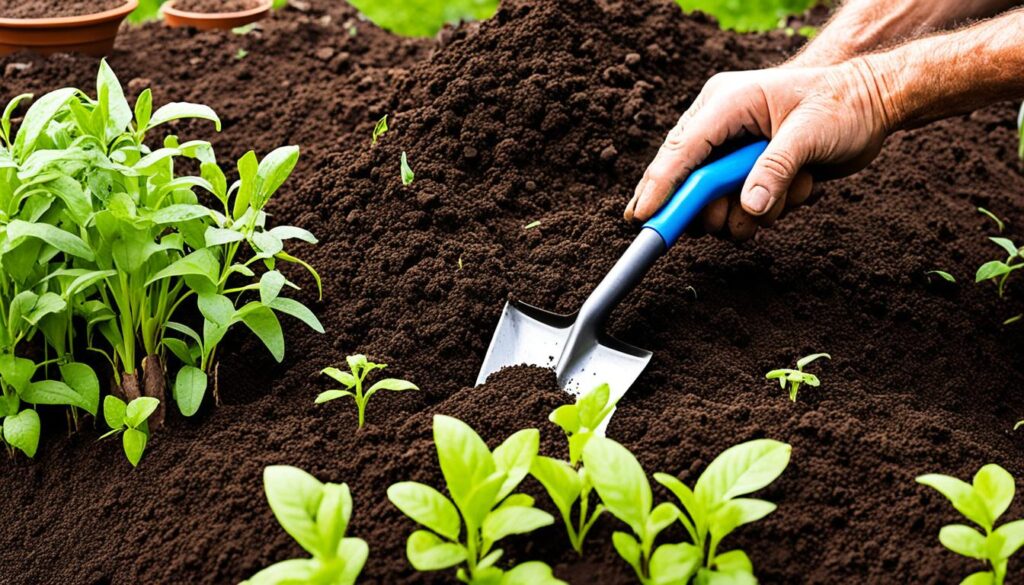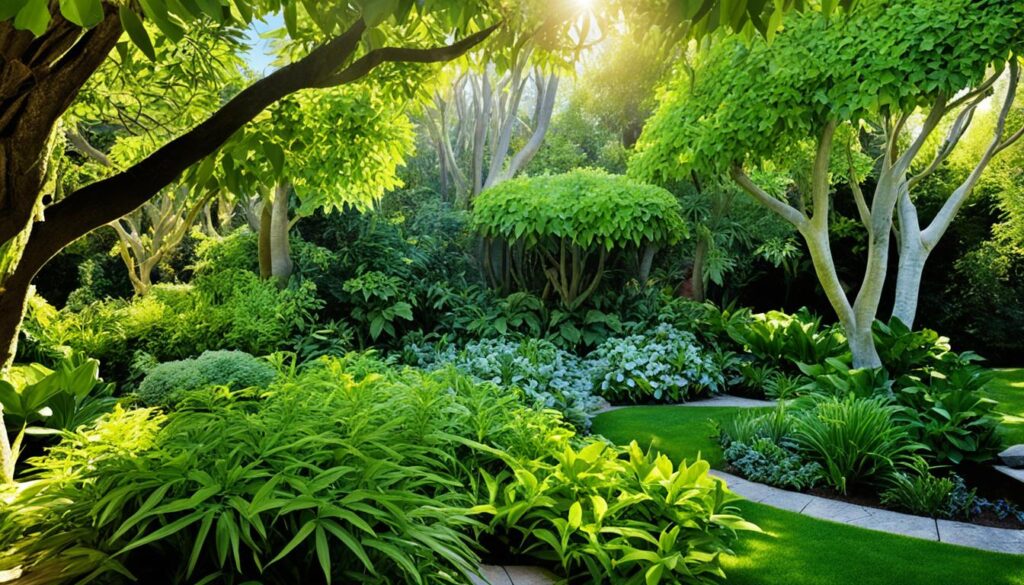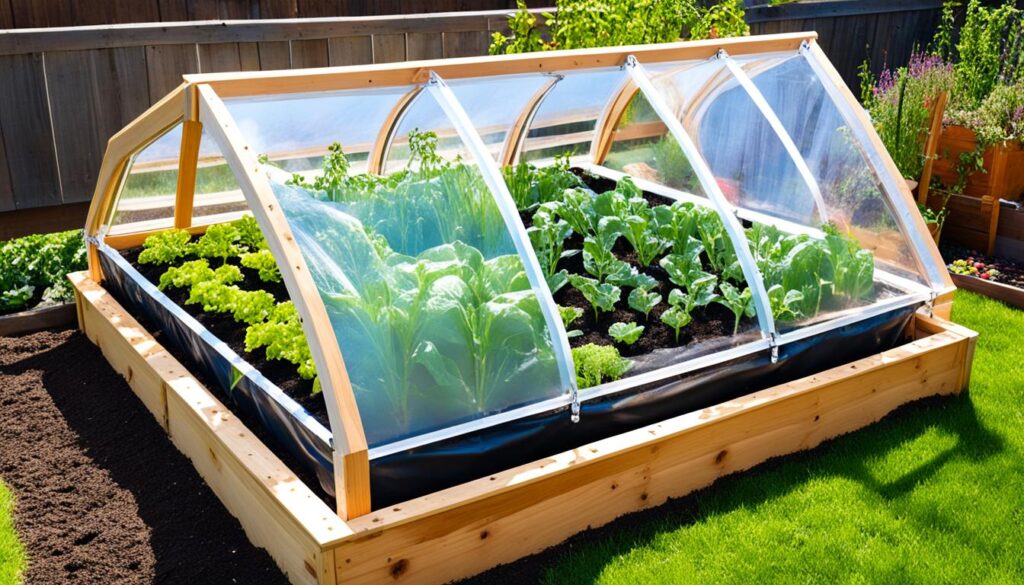Hello there! If you’re an avid gardener or simply someone who loves the beauty of rhododendrons, you might be wondering how to create the perfect acidic soil for these stunning plants. Rhododendrons and azaleas thrive in soil with a pH between 4.5 and 6.0, which falls on the acidic side of the pH scale. In this section, I’ll walk you through the process of acidifying your soil to ensure your rhododendrons flourish.
Before we dive into the details, let’s clarify what soil acidity means. The pH scale ranges from 0 to 14, with 7 being neutral. Soils originating from limestone tend to be alkaline, which is not suitable for rhododendrons. On the other hand, forest soils are usually more acidic and provide the ideal growing conditions. If you’re dealing with alkaline or neutral soil, don’t worry! With a few adjustments, you can create the acidic environment your rhododendrons need to thrive.
Key Takeaways:
- Creating acidic soil is crucial for the successful growth of rhododendrons.
- Rhododendrons require a pH between 4.5 and 6.0.
- Soils originating from limestone are typically alkaline and unsuitable for rhododendrons.
- Forest soils are often naturally acidic, providing a favorable environment for these plants.
- To grow rhododendrons in alkaline or neutral soil, you can adjust the acidity levels through various methods.
Tips for Adjusting Soil Acidity
When it comes to growing rhododendrons, creating the right acidity level in the soil is crucial. Here are some simple yet effective tips to adjust soil acidity:
- Adding sulfur: Sulfur is a commonly used method for lowering soil pH and increasing acidity. It can be applied directly to the soil in the form of elemental sulfur. Just be careful with the application rate to avoid harming the plants.
- Using aluminum sulfate or ferrous sulfate: These compounds are specifically designed to acidify garden soil. They can be easily found at garden centers and can be applied as directed on the packaging. Just mix them with water and soak the soil surrounding the plants.
- Watering with an acidic liquid feed: Another way to increase soil acidity is by watering the plants with an acidic liquid feed. You can use vinegar or lemon juice, which are natural and readily available options. Just dilute them with water and use them as part of your watering routine.
- Using coffee grounds as a mulch: Coffee grounds are not only great for giving you that morning energy boost but also for acidifying the soil. Spread a layer of coffee grounds around your rhododendrons as a mulch. As the coffee grounds break down, they release acidity into the soil.
- Incorporating acidic organic matter: Acidic organic matter, such as pine needles or oak leaves, can be incorporated into the soil to increase acidity. These materials slowly release acids as they decompose, creating a more acidic environment for your rhododendrons.
- Composting and adding well-decomposed compost: Composting is a great way to improve soil fertility and structure. By adding well-decomposed compost to your soil, you can gradually lower its pH over time.
By following these tips and keeping a close eye on the pH levels of your soil, you can provide the ideal growing conditions for your rhododendrons and ensure their healthy development.
Testing Soil pH
Testing soil pH is a crucial step in determining the acidity levels of your soil. By understanding the pH of your soil, you can make informed decisions about the necessary amendments to create the ideal growing conditions for your rhododendrons and azaleas.
One simple and convenient method for testing soil pH is by using a soil pH test kit. These kits are readily available online or at garden centers and provide accurate results within minutes. Testing the pH of your soil will help you determine whether it falls within the preferred pH range of 4.5 to 6.0 for rhododendrons and azaleas.
The pH scale ranges from 0 to 14, with 7 being considered neutral. A soil pH level below 7 indicates acidity, while a level above 7 indicates alkalinity. For acid-loving plants like rhododendrons and azaleas, maintaining a slightly acidic soil pH is essential for optimal growth and health.
Determining Soil Acidity
Once you have obtained a soil pH test kit, follow the instructions provided to collect a soil sample. Typically, this involves gathering soil from several locations within your garden, mixing it well, and placing it in the provided testing container.
Add the appropriate test reagent or indicator solution to the soil sample as instructed by the test kit. The color change will indicate the soil’s pH level. Compare the color of your soil sample with the kit’s color chart to determine its acidity or alkalinity.
Remember, rhododendrons and azaleas thrive in slightly acidic soil with a pH between 4.5 and 6.0. If your soil’s pH falls within this range, you’re already providing an ideal environment for these plants. However, if the soil pH is too alkaline or outside of the desired range, you may need to make adjustments to create the best conditions for your acid-loving plants.
Table: pH Levels and Soil Acidity
| Soil pH Level | Soil Acidity |
|---|---|
| 0 to 4.5 | Highly acidic |
| 4.5 to 6.0 | Moderately acidic (ideal for rhododendrons and azaleas) |
| 6.0 to 7.0 | Mildly acidic |
| 7.0 | Neutral |
| Above 7.0 | Alkaline |
Adjusting Soil pH Levels
Based on the results of your soil pH test, you may need to adjust the acidity levels of your soil. In the next sections, we will explore various methods for acidifying soil, including the use of sulfur, aluminum sulfate, ferrous sulfate, vinegar and lemon juice, coffee grounds, and acidic mulches and compost.
Using Sulfur to Acidify Soil
When it comes to adjusting soil acidity, sulfur is a popular and effective method. It can be used to lower the pH levels of alkaline or neutral soil, making it more suitable for acid-loving plants like rhododendrons and azaleas. Sulfur is readily available in the form of elemental sulfur, a yellow powder that can be directly applied to the soil.
The key to using sulfur is to apply it in the right amount. Too much sulfur can harm plants, so it’s important to follow the recommended application rate. Generally, a rate of 1 to 2 pounds of sulfur per 100 square feet of soil is sufficient for most acidification needs.
If you’re unsure about the soil’s pH or the amount of sulfur to use, it’s always a good idea to conduct a soil test or consult with a gardening expert.
Aside from applying elemental sulfur, you can also incorporate organic matter high in sulfur into the soil. Materials like peat moss or pine straw are rich in sulfur and can help lower the pH levels over time when mixed into the soil. This method not only acidifies the soil but also improves its overall fertility.
It’s best to apply sulfur in the summer or fall before the planting season. This allows it to break down and take effect gradually, creating the ideal acidic environment for your acid-loving plants.
Below is a table summarizing the benefits and application methods of using sulfur for soil acidification:
| Sulfur | Benefits | Application Methods |
|---|---|---|
| Elemental sulfur | • Effective in acidifying soil • Improves nutrient availability • Enhances plant growth and health |
Directly apply to the soil at the recommended rate |
| Organic matter high in sulfur (e.g., peat moss, pine straw) | • Increases sulfur content in soil • Improves soil fertility • Gradually lowers pH levels |
Mix into the soil during soil preparation |
Remember to always follow the instructions on the sulfur product’s packaging and avoid overapplication, as excessive sulfur can have negative effects on plant health.

Using Aluminum Sulfate to Lower pH
If you’re looking to lower the pH of your soil, aluminum sulfate can be a valuable option. This method is commonly used to acidify soil for plants like hydrangeas and is readily available at garden centers. By using aluminum sulfate, you can create the ideal acidity conditions for your plants to thrive.
To use aluminum sulfate effectively, start by mixing it with water. Once it’s dissolved, you can soak the soil surrounding your plants with this solution. It’s essential to maintain the desired acidity level throughout the growing season by reapplying the solution as needed.
In addition to acidifying soil, aluminum sulfate has another remarkable benefit for gardeners: it can turn pink hydrangeas blue! By acidifying the soil with aluminum sulfate, you can change the flower color of pink hydrangeas to a vibrant blue hue.
Take a look at the image below to see the stunning transformation that aluminum sulfate can bring to your hydrangeas:

Using Ferrous Sulfate for Acid-Loving Plants
When it comes to acid-loving plants like camellias, rhododendrons, and azaleas, addressing iron deficiency is crucial for their overall health. This is where ferrous sulfate comes into play as a valuable soil amendment. Similar to aluminum sulfate, ferrous sulfate has the ability to acidify the soil, lower the pH, and make essential nutrients more readily available to the plants.
One common issue experienced by acid-loving plants is yellowing leaves due to iron chlorosis, a condition caused by insufficient iron uptake from the soil. Ferrous sulfate provides a readily absorbable form of iron, effectively addressing this deficiency and promoting healthier foliage.
There are two main methods of applying ferrous sulfate: as a foliage spray or by incorporating it into the soil. As a foliage spray, it can be diluted according to the instructions on the product label and applied directly to the plant leaves. This allows for quick absorption and immediate iron availability to the plants.
Alternatively, for a longer-lasting effect, ferrous sulfate can be mixed into the soil. It is important to follow the recommended application rate to avoid overapplication, which can be harmful to the plants. Adding ferrous sulfate to the soil during the preparation phase or as a top dressing can help acidify the soil and improve its overall suitability for acid-loving plants.
By utilizing ferrous sulfate, gardeners can effectively address iron deficiency in their acid-loving plants, promoting vibrant foliage and overall plant health.
Benefits of Using Ferrous Sulfate:
- Addresses iron deficiency in acid-loving plants
- Helps prevent yellowing leaves due to iron chlorosis
- Acidifies the soil and lowers pH
- Makes essential nutrients more accessible to plants
- Can be applied as a foliage spray or incorporated into the soil
| Ferrous Sulfate Application | Method | Advantages |
|---|---|---|
| Foliage Spray | Directly applied to plant leaves | Rapid iron absorption |
| Soil Incorporation | Mixed into the soil | Extended iron availability |
Using ferrous sulfate is a valuable strategy for acid-loving plants, ensuring they receive the necessary iron and maintaining optimal health. Whether applied as a foliage spray or incorporated into the soil, this soil amendment helps create an acidic environment that supports the growth and vitality of acid-loving plants.

Acidifying with Vinegar or Lemon Juice
If you’re looking for natural ways to lower soil pH and make it more acidic, vinegar and lemon juice can be effective options. These household ingredients can be easily used to create an acidic environment for your acid-loving plants. Let’s explore how you can utilize them in your garden.
Making a Liquid Feed
To provide your acid-loving plants with an immediate pH adjustment, you can create a diluted vinegar or lemon juice liquid feed. When watering plants in pots or raised garden beds, simply mix vinegar or lemon juice with water before applying. Vinegar has a pH of around 2.4, making it a suitable option for acidifying the soil.
Tip: Dilute the vinegar or lemon juice with water to prevent any potential harm to the plants.
Direct Application to Soil
If you prefer a more direct approach, you can also pour diluted lemon juice or vinegar directly onto the soil or use them as a foliage spray. This method allows for targeted application, ensuring that the acidity is concentrated around the roots of your plants. However, exercise caution and perform a soil test before applying to ensure that the pH is within the desired range.
Benefits of Using Vinegar and Lemon Juice
Using vinegar and lemon juice as natural soil acidifiers offers several advantages. They are readily available in most households, making them convenient options for adjusting soil acidity. Additionally, they provide a safe and eco-friendly alternative to chemical-based soil amendments. By using these natural remedies, you can maintain the optimal pH levels for your acid-loving plants while promoting overall plant health.
Summary
Acidifying soil with vinegar or lemon juice is a natural and effective way to lower soil pH and create the ideal conditions for acid-loving plants. Whether you choose to make a liquid feed or apply them directly to the soil, vinegar and lemon juice offer an accessible solution for maintaining soil acidity. By incorporating these natural remedies into your gardening routine, you can help your plants thrive and flourish.
Using Coffee Grounds to Increase Soil Acidity
Coffee grounds are a fantastic natural solution for increasing soil acidity. Not only are they readily available, but they can also be a great way to boost the acid content of your soil and provide essential nutrients for your acid-loving plants.
When it comes to acidifying soil with coffee grounds, there are a few different ways you can go about it. One option is to simply mix the coffee grounds directly into the soil. This allows for a slow release of acidity as the coffee grounds break down over time. It’s important to thoroughly incorporate them into the soil to ensure an even distribution.
Another method is to use coffee grounds as a mulch. This involves spreading a layer of coffee grounds on top of the soil around your plants. The coffee grounds will gradually decompose and release acidity into the soil as they break down. However, it’s important to avoid sprinkling the coffee grounds directly on top of the plants, as this can attract molds and other pathogens.
Using coffee grounds as mulch has the added benefit of enriching the soil with organic matter. Coffee grounds contain nutrients like nitrogen, phosphorus, and potassium, which are essential for plant growth. This makes them not only a great way to increase soil acidity but also an excellent natural fertilizer for acid-loving plants.
To give you a better idea of the pH levels that coffee grounds can help achieve, here’s a table showing the pH range of some common household items:
| Household Item | pH Level |
|---|---|
| Coffee Grounds | 4.8-5.8 |
| Vinegar | 2.4 |
| Apple Juice | 3.3-4.0 |
| Orange Juice | 3.5-4.5 |
As you can see, coffee grounds have a pH level of 4.8-5.8, which falls within the acidic range. This makes them a perfect choice for acidifying your soil and creating the ideal conditions for your acid-loving plants.
Acidifying Mulches and Compost
Certain types of mulch and compost can help increase soil acidity over time. Mulches made from pine needles or oak leaves are particularly effective in maintaining the desired pH level for acid-loving plants.
These materials slowly break down, releasing acids into the soil and helping to create an acidic environment. Pine needles and oak leaves are abundant sources of natural acidity that can be easily incorporated into your garden soil.
When using pine needles as mulch, spread a layer of needles around the base of your plants. As they decompose, the acidic compounds in the needles will gradually lower the pH of the soil, providing an optimal environment for acid-loving plants like rhododendrons and azaleas.
“Pine needles are a fantastic and earth-friendly mulching option for acidifying your soil. Not only do they help maintain the acidity levels, but they also provide insulation and moisture retention for the roots of your plants.”
Oak leaves can also be used as mulch, serving a similar purpose in acidifying the soil. Collect fallen oak leaves and spread them around your acid-loving plants, allowing them to decompose naturally. As the leaves break down, they release tannic acid, further acidifying the soil.
Note: It’s important to note that while pine needles and oak leaves can help acidify the soil, their effects are gradual and may take time to become noticeable. Regular soil testing can help you monitor the pH levels and make any necessary adjustments.
| Type of Mulch | Acidity Level |
|---|---|
| Pine needles | Highly acidic |
| Oak leaves | Acidic |
Using Acidic Compost
In addition to using acidifying mulches, incorporating acidic compost into your soil can also help lower pH levels and improve soil acidity.
Composting organic matter that is high in acid, such as pine needles or oak leaves, can create a nutrient-rich and acidic compost. This can be achieved by layering these materials with other compostable materials, such as vegetable scraps, coffee grounds, and grass clippings.
As the composting process occurs, beneficial microorganisms break down the materials, releasing organic acids into the compost and lowering its pH. Once the compost has fully decomposed, it can be added to the soil, improving its acidity and providing essential nutrients for acid-loving plants.
Remember to test the pH of your soil periodically to ensure it is within the ideal range for your acid-loving plants.
Conclusion
In conclusion, adjusting soil acidity is crucial for the optimal growth and health of acid-loving plants such as rhododendrons and azaleas. By following the tips mentioned in this article, gardeners can create the ideal conditions for these plants to thrive.
Using methods such as sulfur, aluminum sulfate, or ferrous sulfate can help lower the soil pH and make it more acidic. Watering with an acidic liquid feed, incorporating coffee grounds, and adding acidic mulches or compost can also contribute to maintaining the desired acidity levels.
Regular soil testing and monitoring are essential for long-term plant success. By testing the pH levels and making necessary adjustments, gardeners can ensure that their acid-loving plants have the ideal environment for healthy growth.
With these techniques and proper care, gardeners can successfully grow beautiful rhododendrons and azaleas that will thrive in their gardens.

